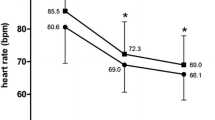Abstract
A multicenter, double-blind study was performed to compare the efficacy and safety of the calcium antagonists, amlodipine and diltiazem controlled release (CR), in patients with stable angina pectoris. One hundred and thirty-two patients were randomized to receive either amlodipine (5–10 mg) once daily or diltiazem CR (90–120 mg) twice daily for 8 weeks. A standard bicycle exercise tolerance test was used for the primary efficacy assessment. The median time to 1 mm ST-segment depression and time to onset of chest pain were increased by 16% (P < 0.0001) and 13% (P < 0.0001) with amlodipine, and by 16% (P < 0.0001) and 7% (P = 0.009) with diltiazem CR, respectively. Amlodipine, but not diltiazem CR, also produced a significant improvement in the median time to end of exercise of 5% (P < 0.0002), although the between-treatment difference for this parameter was not statistically significant. The number of angina attacks and nitroglycerin (NTG) tablet consumption were similar with both agents. Amlodipine was withdrawn in 3% and diltiazem CR in 9% of patients due to adverse events. The adverse events were reported by 15% of patients on amlodipine and 26% of those on diltiazem CR. The results from this study demonstrate that both drugs have a comparable therapeutic effect and possibly that amlodipine was better tolerated in patients with stable angina. Furthermore, amlodipine has the advantage of once-daily dosing and so may also be beneficial in ensuring good patient compliance.
Similar content being viewed by others
References
Perondi R, Saino A, Zanchetti A, Mancia G. Coronary vascular reactivity and calcium antagonist therapy in patients with angina. J Cardiovasc Pharmacol 1994;24(Suppl. A): S30–S36.
Murdoch D, Heel RC. Amlodipine. A review of its pharmacodynamic and pharmacokinetic properties, and therapeutic use in cardiovascular disease. Drugs 1991;41:478–505.
Haria M, Wagstaff AJ. Amlodipine. A reappraisal of its pharmacological properties and therapeutic use in cardiovascular disease. Drugs 1995;50:560–586.
Brorson L, Arvill A, Löfdahl P, et al. Conventional and controlled release diltiazem. Bioavailability in healthy volunteers and anti-anginal effects in combination with metoprolol in stable angina pectoris. Eur J Clin Pharmacol 1994; 47:75–79.
Opie LH, Singh BN. Calcium channel antagonists (slow channel blockers). In: Opie LH, ed. Drugs for the Heart, 4th ed. Philadelphia: W.B. Saunders, 1997:50–82.
Chaffman M, Brogden RN. Diltiazem: A review of its pharmacologic properties and therapeutic efficacy. Drugs 1985; 29:387–454.
Singh BN. Silent myocardial ischemia: Historical development of the concept and scope of the clinical problem. In: Singh BN, ed. Silent Myocardial Ischemia and Angina. Prevalence, Prognostic, and Therapeutic Significance. New York: Pergamon Press, 1988:3–15.
EC Note for Guidance: Good Clinical Practice for Trials on Medicinal Products in the European Community: The Rules Governing Medicinal products in the European Community. Vol. 3, Addendum July 1999, ISBN 92-826-0421-7.
Bernink PJLM, de Weerd P, ten Cate FJ, Remme WJ, Barth J, Enthoven R, and co-investigators. An 8-week double-blind study of amlodipine and diltiazem in patients with stable exertional angina pectoris. J Cardiovasc Pharmacol 1991;17(Suppl. 1):S53–S56.
Canale C, Terrachini V, Masperone MA, Caponnetto S. Open comparative study to assess the efficacy and safety of two calcium antagonists: Amlodipine and diltiazem in the treatment of symptomatic myocardial ischaemia. J Cardiovasc Pharmacol 1991;17(Suppl. 1):S57–S60.
Mulcahy D, Purcell H, Sparrow J, Cunningham D, Wright C, Fox KM. Effects of amlodipine versus diltiazem on morning peak in myocardial ischemic activity in angina pectoris. Am J Cardiol 1993;72:1203–1206.
Deanfield JE, Detry J-MRG, Lichtlen PR, Magnani B, Sellier P, Thaulow E. Amlodipine reduces transient myocardial ischemia in patients with coronary artery disease: Double-blind Circadian Anti-ischemia Program in Europe (CAPE Trial). J Am Coll Cardiol 1994;24:1460–1467.
Gaffney M, Taylor C, Cusenza E. Harmonic regression analysis of the effect of drug treatment on the diurnal rhythm of blood pressure and angina. Stat Med 1993;12: 129–142.
Kubota K, Pearce GL, Inman WHW. Vasodilation-related adverse events in diltiazem and dihydropyridine calcium antagonists studied by prescription-event monitoring. Eur J Clin Pharmacol 1995;48:1–7.
Author information
Authors and Affiliations
Rights and permissions
About this article
Cite this article
van Kesteren, H., Withagen, A. A Comparative Study of Once-Daily Amlodipine versus Twice-Daily Diltiazem Controlled Release (CR) in the Treatment of Stable Angina Pectoris. Cardiovasc Drugs Ther 12 (Suppl 3), 233–237 (1998). https://doi.org/10.1023/A:1007726109850
Issue Date:
DOI: https://doi.org/10.1023/A:1007726109850




